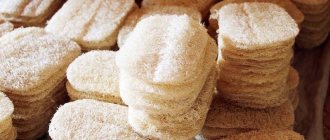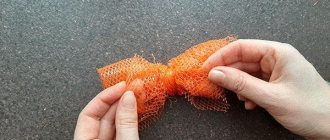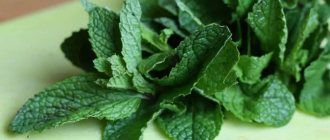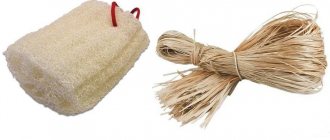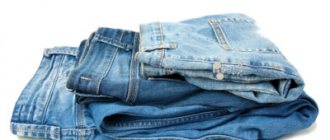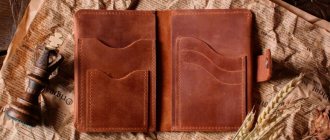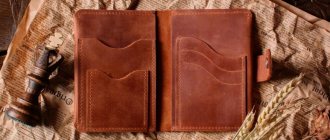Today everything natural is in fashion. Natural food, natural cosmetics, clothing made from natural fibers. The bathhouse is generally a stronghold of naturalness, starting from the logs and ending with the broom. Naturally, in the realm of environmentally friendly items there should be no exceptions, even in such little things as washcloths. No synthetics. Why is she in the bathhouse if there is such a wonderful product in the world as a loofah washcloth? Our story today is about her.
What is luffa?
Luffa belongs to the pumpkin family and is considered to be native to Asia. Its appearance resembles a liana and can reach a length of up to 5 meters; thanks to these qualities, this plant is often used as a hedge.
Forms a weak root system that is located on the surface.
The fruits can reach a size of 70 centimeters. Depending on the degree of maturity, there are several ways to use them:
- Young fruits are widely used in cooking; they are prepared in the same way as zucchini. They have many useful qualities and are appreciated by lovers of tasty and healthy food.
- Mature specimens make an excellent luffa washcloth. This unusual use is due to the structure of the vegetable. When the fruit is fully ripe, it becomes strong, fibrous and reticulated.
How to care for a loofah
The problem with all natural washcloths is that too many different bacteria and microbes like to make their permanent home in them. Here is another proof that all living things in the world love natural things!
However, if you want to use a loofah sponge for as long as possible, you cannot allow “tenants” into its porous structure. They will simply eat your washcloth, the fibers will spread, it will become frayed and torn.
That is, you definitely need to take care of your washcloth! After use, rinse it thoroughly, pour boiling water over it and be sure to dry it! In the bathhouse, the drying process happens somehow by itself - the kingdom is hot, the queen of the oven rules the show and dries everything!
But in an apartment, in a wet bath, the service life of a washcloth is significantly reduced. You can try drying it on a hot radiator in winter, and in open air in summer (for example, on a balcony).
This is my story about a natural loofah made from luffa. Of course, no two people are the same; everyone has different tastes and preferences. But this washcloth has taken root in our family for so long that I recommend that you get to know it. I think you won't be disappointed!
Beneficial features
Loofah seeds contain a huge amount of edible oil and protein. Luffa is included in many cosmetic products.
There are also vegetable and technical varieties of this plant. They differ in the quality of the oil obtained and in the scope of its use. Technical varieties are used to prepare loofah, and the oil obtained from the seeds is included in various face masks and other cosmetics. Food grades are used in cooking.
Not only the fruits and seeds of the plant, but also their green part have beneficial properties. For example, the juice from luffa stems in Japan is widely used to create lipstick or used as a lotion to cleanse the skin.
Before World War II, luffa (loofah) was used for industrial production. Due to its light and porous texture, it was used in various filters and diesel parts.
Also, due to good sound insulation and high strength, the fruits of the plant were used as an inner layer in the manufacture of steel helmets and automotive equipment for the US Army.
Loofah - a useful plant
The loofah plant is a genus of herbaceous vines in the Cucurbitaceae family. It grows naturally in regions of Asia and Africa. Is it possible to grow this plant here in Russia? Of course you can, it grows very well in the southern regions by sowing seeds in the ground. In our Volga-Vyatka region and central Russia, loofah is grown using seedlings. But more on that later.
Loofah, an annual beautiful and branched plant - liana. The shoots reach a length of 5 meters. The fruits grow up to 70 cm long. It can decorate and shade a gazebo, form a beautiful hedge, and you will get washcloths from its fruits and wonderful cosmetics from its stems and leaves. Young, unripe fruits are eaten, and folk medicinal drugs are prepared from them.
Eating unripe fruits helps strengthen the immune system and helps fight flatulence and bloating, treat chest cough, and increase lactation in nursing mothers.
Types of luffa
One of the most specific representatives of the pumpkin family is the luffa. Many gardeners who are just starting to grow it on their plots want to know how to make a loofah from a plant. First you need to choose the right variety.
- Luffa sharp-ribbed - this subspecies of the plant is much easier to grow because it is less demanding on soil and care, and it is also less susceptible to various diseases. The flowers bloom at night, so they are pollinated by nocturnal insects or by hand. The fruits should be consumed before full ripeness, when their size is 30-40 centimeters, otherwise the taste of the product will change and be bitter. In its shape, luffa of this variety resembles a cone or club, the surface is ribbed, the skin is difficult to separate from the pulp.
The fruits are consumed in the same way as cucumbers. But at the same time they are included in curries and added to soups. The leaves, shoots and flowers of the plant are also edible; by simmering them for a few minutes and mixing them with oil, you can get an unusual and tasty side dish.
- Cylindrical luffa - this is the subspecies suitable for making loofahs. The length of the fruits can reach 70 centimeters, becoming slightly pointed towards the stalk. They are distinguished by thin skin, which is easy to separate, and delicate white pulp. According to the method of preparation, it is no different from sharp-ribbed luffa.
Tips for growing luffa
- Germination can take up to 14 days, so patience is required.
- Before planting, soak the seeds overnight in a glass of water to speed up germination.
- Plant 3 or 4 seeds a few centimeters apart in a group, pushing them 1 centimeter into the soil.
- Create spatial groups at a distance of 15 to 20 centimeters
- Once the plants reach 30 cm in height, thin out the smaller seedlings from ground level, leaving only the strongest to grow, one or two per group.
Growing seedlings
Many summer residents are wondering how to plant and grow luffa (loofah). The answer lies in the biological characteristics of this plant. It has a fairly long growing season, so the process usually begins with germination of seedlings.
- Since luffa seeds are very hard and covered with a thick shell, they need to be prepared for planting. To do this, about a week before work, they need to be placed in a very warm place, with an air temperature of at least 40 degrees.
- Then they need to be soaked in aloe juice for 20-30 minutes.
- You need to start growing seedlings in early April so that the fruits have time to ripen before the onset of winter cold.
- The soil must be nutritious and loose, in order to avoid the occurrence of bacterial diseases, it should be disinfected.
- The first shoots should appear 5-6 days after sowing.
- In order for the luffa (loofah) to receive as many nutrients as possible, when growing seedlings it needs to be watered twice with mullein diluted in water in a ratio of one to ten.
Hypoallergenic eco-body washcloth
To do this, I clean the fruit in the same way as shown above; if you wish, you can soak it in a bleach solution for a while if you want to lighten it. Then rinse well. If the fibers are a bit harsh, you can boil them in a soda solution for about an hour. I straighten and dry it in the same way.
I cut out the desired shape from the prepared loofah.
I take terry cloth, in this case a terry towel. To make the water hold better, I make it thicker - I cut out 2 parts from terry.
I fold everything with the right sides inward, stitch it with a loofah, and moisten it if necessary.
I turn it inside out and sew in a loop. To prevent the layers from shifting, I quilt them.
In general, there are many options - you don’t have to turn it inside out, you can just edge it with tape, or you can put a layer of foam rubber inside. I know that this loofah is used to make a cover for mugs, it is decorative and the tea stays hot longer.
In stores, of course, there are loofah sponges for sale, but sometimes it’s more interesting to grow them yourself.
3
2
Copy link
How to choose a place for a luffa?
Before planting a luffa, you need to choose the right place in which the plant will feel as comfortable as possible:
- Luffa (loofah) does not tolerate strong winds.
- Loves sunlight.
- The plant can be planted both in a greenhouse and in open ground.
- Before planting, you need to take care of the support; it must be strong and strong, because the plant grows very quickly and gains weight. An example would be a trellis, stretched twine, or even a metal mesh fence.
Loofah - edible healing sponge
24.02.2020
Despite the fact that eco-friendly washcloths are often made from loofah, many in our country are not familiar with this plant. Although it is exotic, it grows well here too. Once you grow a loofah and add it to your diet, testing it as a cosmetic, medicinal and handy home remedy, you will not remain indifferent to it. Moreover, this plant is not very whimsical.
The name “loofah” is given to a whole galaxy of herbaceous tropical vines from the Pumpkin family. In nature, there are more than 50 varieties of this plant, but only two of them are used for domestic needs - sharp-ribbed and cylindrical. All the rest grow too small and do not have the necessary physical characteristics for which large fruits are valued.
Externally, luffa (luffa, luffa) resembles its close “relatives” - zucchini and cucumber.
The ribbed loofah is grown mainly for its fruits, which, when unripe, are used like ordinary cucumbers in salads, soups, side dishes and other dishes. The fruits are long, from 30 cm or more, the pulp of the greens is starchy and tasty. Loofah contains 1.5 times more carotene than sweet peppers and carrots. It is also grown for its seeds, which contain about 50 percent edible oil. But the oil obtained from cylindrical loofah is poisonous, not suitable for food and is used only as a medicine.
The fruits of the cylindrical (loofah) loofah are also edible at a young age, but by the end of summer they become woody, dry out and are used to make washcloths, various decorative crafts and other household items.
Ribbed luffa | Cylindrical luffa |
When grown in our conditions, the harvest can be 7-12 young fruits weighing 2-3 kg. As they ripen, they lose moisture and their weight decreases.
This vine is native to the subtropical and tropical regions of Asia and Africa. It is grown commercially today in China, Japan, Indonesia, the Philippines, Hong Kong, Brazil and the Caribbean. You can successfully grow loofah on an industrial scale in the south of the Caucasus, in the Krasnodar Territory and in the Crimea.
This amazing plant can be a real decoration of the garden - it looks elegant throughout the entire growing season.
Loofah can be eaten, used to treat certain diseases, used as bath accessories and cosmetics, and can also be used to make stylish, eco-friendly interior items.
Even before the middle of the last century, technical parts were produced from the ripe fruits of the cylindrical loofah - filters, seals for mechanisms, etc. Now they have been replaced by synthetic materials...
What are the benefits of luffa?
The leaves of this plant contain a lot of carotene, vitamin C, iron and protein. It can be an excellent source of polyunsaturated fatty acids, phosphorus, calcium, magnesium, zinc, vitamins A, B and C.
The leaves, fruits, and seeds of the plant are a folk remedy for many diseases. In eastern countries, a decoction is prescribed for eczema, dermatitis, dropsy, leprosy, and hemorrhoids. In Africa, the juice of the leaves is used to treat conjunctivitis. By drinking the juice orally they fight jaundice, and by rubbing it they treat wounds and ulcers. Loofah is useful for anemia, bronchopulmonary, joint diseases, and helps young mothers increase lactation.
Loofah dressings (designed by Mauricio Afonso) are a better alternative to plaster.
What can you make from loofah?
Unripe loofah fruits have a delicate, pleasant taste that is similar to the taste of zucchini and cucumber.
Young loofah fruits, 10-20 centimeters long, are eaten as long as they retain their delicate taste and aroma, as well as shoots, leaves, buds and flowers. The green mass is stewed and served as a side dish. The shoots and buds are good in salads.
The juice of young leaves has a peculiar bitter-musky taste.
The tender green loofah fruits are eaten raw, boiled, stewed, fried, stuffed and pickled. Place in soups, stews, salads, stew with mushrooms or beans. Fruit pulp is added to omelettes.
The seeds, similar to watermelon, can be roasted and eaten as sunflower seeds.
Loofah goes well with olive oil, soy sauce, garlic, pepper, ginger, cumin, as well as legumes, seafood, rice and rice noodles.
For storage, luffa fruits are washed, peeled, cut and frozen. Young fruits are cut into slices and dried.
Loofah loofah
This plant sponge does not cause allergies, and at the same time as washing it provides a good massage of the skin and muscles of the body. Due to its rigidity, it has a peeling effect. After washing your skin with such a washcloth, it becomes as soft as a child’s.
At the same time, you need to know that the degree of hardness of a loofah depends on its maturity - the more mature the plant is, the harder its pulp will be. Its age is visually determined using the size of the washcloth itself and the size of its cells. The larger they are, the rougher the loofah. Sometimes dark seeds can be found in the mesh mass. They are also an indicator of maturity, and therefore toughness. These washcloths should not be used by people with sensitive skin.
After each use, the vegetable sponge should be thoroughly washed with soap, preferably with laundry soap, and dried on a radiator.
How to make an eco-loofah sponge?
Quite simple. To do this, the ripe fruits need to be dried a little. When the seeds begin to make noise when shaken, the ends of the fruit need to be cut off and the peel carefully removed. Next, the loofah is poured with boiling water, wrapped and left for 15-20 minutes. You can also boil the prepared fruits for 15 minutes in a soap solution. Then the loofah is cooled, the seeds are shaken out, the remaining peel is removed, washed, dried and decorated in the form of a washcloth.
Fruits processed in this way are also used as insoles for shoes and linings for hats.
The loofah is also used to make scrub soap. This soap opens pores, facilitates skin breathing, and stimulates blood and lymph circulation.
How to make soap with loofah?
In a water bath, without bringing to a boil, melt baby soap or soap base with the addition of a small amount of water. If desired, add vegetable dye (beet juice, onion peel decoction, St. John's wort or other natural dyes), essential oils for flavoring, as well as base oils: peach, almond, olive or any other.
Mix the mixture thoroughly. Place the prepared loofah into a suitable cylindrical container and fill with soap mixture. When the soap has cooled, remove it from the container and cut into pieces.
In addition, the loofah is suitable for makeup removing sponges and sponges. Apply cleanser to a dampened sponge and wipe your face in a circular motion, then rinse with warm water.
And from the young stems and leaves of the loofah, you can prepare a skin-whitening lotion. Just squeeze out the juice and wipe your face and hands with it.
Design ideas with loofah
Thermos and mugs with loofah inserts. They are comfortable to hold in your hands without the risk of getting burned:
Original lampshade made of loofah. When heated by a lamp, it does not emit unpleasant odors, unlike synthetic materials:
Acoustic loofah wall tiles provide excellent sound insulation:
Cute bath slippers:
Interior toys made from loofah:
Dental toys for animals are gaining popularity in Japan.
How to grow loofah loofah?
Since loofah is a heat-loving plant and has a long growing season, it is best to grow it in seedlings or in a greenhouse.
If you want to grow a loofah with long fruits, then the seeds for seedlings should be sown already in January, since the loofah needs a long photoperiod and an elevated temperature of up to 25 degrees Celsius. For the sake of growing only edible fruits, seeds of both types of loofah can be sown as seedlings in early April.
Growing loofah seedlings is a complex process. Its seeds are very hard, covered with a thick shell and require heating for a whole week at a temperature of about 40 degrees before sowing. They must be sown sprouted in pots with a diameter of 4x4 cm, and after two weeks the seedlings are transplanted with a lump of earth into larger containers with a diameter of 8-10 cm. After 20-25 days, another transplant, this time into pots with a diameter of 13-15 cm, in which the seedlings remain until planted in the ground in a permanent place. For planting in open ground, choose warm, sunny and windless areas of the garden. And don’t forget to provide a good support for the vine.
Already 10 days after the final transplantation, young lufina cucumbers can be used for food.
By mid-August, the fruits of the cylindrical loofah begin to coarse and become tough. At the stage of technical ripeness, they are only suitable for washcloths. To obtain longer sponges, the side shoots are pinched, and 9-10 fruits are left on the main stem. If the loofah does not grow in a greenhouse, then in August it is advisable to cover it with film. This accelerates the formation of a dense network of fibers. By the end of the season, they form a strong frame from which the washcloth is made.
By this time, loofah fruits can grow up to 1 meter in length. They turn yellow-brown and become so dry that the seeds begin to rattle when the fruit is shaken, and easily spill out through the hole made at the end of the fruit.
If you provide the loofah with the proper conditions, you can get up to 12 large fruits from one plant. When they ripen, they dry out and decrease in size. You should remove washcloths with the onset of cold nights, when the temperature drops below +10C. At the same time, you can cut even unripe fruits - they will “reach” in the room or on the windowsill.
Growing loofah from seeds is a painstaking but exciting task.
By planting this exotic plant on your property, you will provide yourself and your loved ones with a natural hygiene product, a tasty food product and valuable medicine, as well as an excellent material for decorative interior work and creative crafts. It is also important that loofah is one of the few cheap environmentally friendly materials that is fully recyclable. Draw the rest of your conclusions yourself.
© Methodical
Other articles on the topic "Sanity"
If you want to always learn about new publications on the site in a timely manner, then subscribe to our newsletter.
Transplantation into open ground
After the issue with the location has been resolved, it is necessary to plant the plants themselves. If the luffa is placed in a greenhouse, then the optimal time will be the second half of May, and if open ground is chosen as a permanent place of growth, then all work should be postponed until the beginning of June.
Before planting, you need to prepare holes, the depth and width of which will be 30 centimeters. The distance between plants should be at least one meter.
In order for the luffa (loofah) to take root as best as possible in a new place, the soil must be fertilized:
- You need to pour half a bucket of humus into the bottom and add 2 tablespoons of potassium sulfate there.
- Or you can use half a glass of ash per plant.
The luffa needs to be deepened to the cotyledon leaves, then the roots are carefully dug in; it is very important not to damage them during planting.
Natural loofah material for washcloths
The production cycle of the starting material is simple, but long. In the spring, seeds are selected and sowed in cups, and then the grown plants are planted in a greenhouse or open ground. Loofah (loofah gourd, crazy cucumber) is a vine that can grow up to 6 m, and each fruit weighs up to 3 kg, so it is necessary to use a chain-link mesh as a support. In addition, regular watering and fertilizing are needed.
All fruits, even unripe ones, are collected before frost begins. Those intended for making washcloths (smooth, long and “bellied”) need to be hung to dry in a vertical position in a net or on a string. When you want a soft sponge, choose green fruits; if you want a harder sponge, choose brown ones. The room should be warm and well ventilated. To determine whether the loofah is ready for use, you need to shake it. If the seeds inside the fruit are knocking, as in maracas, loofah production can begin.
Plant care
Many people are interested in such a plant as luffa. How to make a washcloth? To make a bath accessory, you first need to grow high-quality fruits.
Luffa leaves absorb a huge amount of moisture, so you need to carefully ensure that the soil does not dry out and the plant has constant access to the necessary nutrients. Water for irrigation must be warm, otherwise the luffa may die. Experienced gardeners also recommend spraying the vine itself once every two weeks or using a sprinkler.
As soon as the first mature ovaries are formed, you need to select 3-5 of the strongest ones, the rest need to be plucked out. In order for nutrients to reach the fruit, it is better to remove the side branches, the same applies to excess green mass.
Luffa, like any other plant, requires a large amount of oxygen, so the soil needs to be loosened three times a season, given the shallow root system, this procedure must be carried out very carefully.
Pollination - initially only female flowers are formed, male flowers begin to appear only after 10-12 days. Given the nature of the plant, it is almost impossible to pollinate it with the help of insects; the most reliable way is to use the manual method. It will be possible to find out whether the work was carried out successfully or not in a few days; the pollinated ovaries increase significantly in size.
Agricultural technology for wet production
The famous money-grubber, Father Fyodor Vostrikov from the immortal work “The Twelve Chairs,” dreamed of a candle factory near Samara, which would help him spend the rest of his days in prosperity and luxury in his own house with servants. Who knows, maybe for someone opening their own basting production will be the beginning of the path to great success.
The key advantage of this plant is that its well-ripened fruits make excellent natural washcloths. They gently and delicately cleanse the skin of keratinized epidermis, relieve inflammatory processes on the surface of the skin, and are an absolute hypoallergen. In general, the use of such a washcloth is a kind of symbiosis of a soft scrub and a delicate superficial massage.
The technology for growing this plant is similar to the methods of agricultural technology for melons, in particular cucumbers. For planting, it is necessary to allocate well-drained fertile areas illuminated by the sun. Trellis should be recognized as a rational method of placement. It is in this way that it will be possible to achieve uniform illumination of plants and avoid thickening, in which the level of fruiting is reduced to 30%, and the fruits become smaller by almost half. By the way, about productivity. On 1 acre you can rationally place 30 plants, from the fruits of which you can make about 900 washcloths. Considering the cost of one washcloth in a retail chain, you can fairly accurately predict expected income. The main agricultural practices are as follows:
- One of the zoned varieties for the southern regions of the country should be recognized as the “Cylindrical” variety;
- Direct sowing of seeds into the soil is associated with the risk of late frosts, so preference should be given to growing through seedlings. It is sown in peat pots in March and the ambient temperature is maintained within 24-28 degrees Celsius. The seedlings are watered abundantly, not forgetting that air humidity for pumpkin plants is a very important factor for the successful growth and proper development of seedlings;
- When the first natural leaf appears, the temperature is reduced by 3 degrees Celsius;
- Seedlings at 6 weeks of age can be hardened off;
- Planting is carried out in southern, well-lit areas, when the danger of night and morning frosts has passed;
- Due to the shallow root system of this plant, you should immediately take care of the presence of support for the stem;
- The distance between adjacent roots should be at least 150 - 170 cm;
- When the central stem reaches a length of 500 cm, it must be pinched and thereby provoke the development of lateral shoots and increase the yield;
- During the growing season, young shoots and leaves can be removed without creating zones of local thickening.
Attention! Young leaves and shoots should not be thrown away as they are an excellent base for an effective skin care product. The green mass is finely chopped, 100 g. leaves and shoots add 5 drops of unrefined olive oil, 10 g. flower honey. The mass mixes well and is applied to the skin for 10 minutes, after which it is washed off with warm water.
For clarity and understanding of the principles of basic agrotechnical practices, we will form them in the form of a table:
| Name of agrotechnical technique or operation | Its general characteristics |
| Growing and forming a central shoot | No more than 500 cm. The crown is pinched in the classic way |
| Growing and forming side shoots | Shoots from the axils of 5-6 leaves are left 50-70 cm long and pinched. Shoots from the axils of subsequent leaves are left 80-100 cm long and pinched. |
The final ripening of the fruit begins in the first ten days of October and lasts until the end of the month. Harvesting and using fruits for making washcloths has its own subtleties.
Bast from a tree - do it from the beginning
Our loofah is ripe, how to make a washcloth? If you need a soft and tender washcloth, then the fruit must be removed approximately 7-10 days before full ripening and placed to dry in a well-ventilated area, away from direct sunlight. If the goal is to obtain a more rigid product and, accordingly, more durable, then it is worth waiting for final ripening directly on the plant’s vine.
Important! Fruit harvesting must be completed before the onset of autumn frosts.
Drying of fruits is carried out within 5-15 days, depending on specific conditions; the rustling of seeds in the seed pods can be considered a signal that the fruit is ready for further use, if you shake the fruit well. The most important process is removing the skin from the fruit.
Experts are divided into two stable camps, adherents of boiling and supporters of soaking. Let's consider both methods:
- The dried fruit is soaked in warm water for 1.5 - 2 hours, after which the skin is removed by making several shallow cuts along the entire length of the fruit.
- The dried fruit is soaked in cold water for 15-20 minutes, then placed in boiling water for 10-12 minutes, boiled and removed, placed in cold water for 2-3 minutes until it cools. The peel is removed with a stocking, through a single shallow incision made along the length of the fruit.
A word from Experienced! A good tool for making cuts in the fetus is a utility knife. It has a sharp blade and allows good control over the depth of the cut.
To be fair, it is worth noting that there is also a third camp. Its adherents remove the skin and seeds from the dry fruit without soaking or boiling. But this, as they say in Odessa, is “purely for the true amateur.”
The pulp, cleared of skin and seeds, is trimmed at the ends, washed in a saturated solution of laundry soap and dried. Now the raw material can be molded into a future washcloth. Here the field for flight of imagination is truly limitless. Some people limit themselves to a classic rectangular-shaped washcloth with ribbons for holding, some make a mitten for massage, others make a washcloth in the form of intricate geometric shapes or animals.
The use of plant-based washcloths
The use of washcloths made from natural raw materials involves several points:
- Before use, soak such a washcloth in warm water for 3-5 minutes.
- You can use the product no more than 2 times a week.
- The total service life of such washcloths, subject to storage conditions, can be 2-3 months.
- Store well dried in a cool, dry place, away from direct sunlight.
The overall service life of this type of sponge directly depends on the quality and strength of the plant fibers that form the basis of the fruit. In addition, it should be remembered that the older the fruit is, the more fully it has ripened in natural conditions, directly on the plant’s vine, the longer it will last. True, although such washcloths are more durable, they are also rougher to use.
Fertilizing
You can fertilize the plant using the following substances:
- Ammonium nitrate is used during planting, second and third loosening.
- The mullein solution must be mixed with water in a ratio of 1 to 10. Fertilizing is done during the period of ovary formation.
- Complex fertilizer - you can use 1 tablespoon of nitrophoska diluted in a bucket of water. This procedure is carried out in the middle of the growing season.
- Superphosphate extract - 1 tablespoon of the substance is diluted in a bucket of water. This feeding promotes the ripening of seeds and the best ripening of the fruit.
When to collect luffa for sponging?
To use the fruits in cooking, they must be collected while they are young. But as for the manufacture of bath accessories, the time of removal will depend only on the desire of the person himself.
To get a soft loofah, you should collect green fruits, but for tougher specimens, mature, brown luffa is suitable. A prerequisite is to harvest the crop before frost, otherwise it will be unsuitable for use.
Varieties of luffa
There are more than 50 species of luffa, but only two types of plants have become widespread. Other types of plants produce too small fruits and require quite a lot of care. Therefore, it makes no sense to grow them
- Luffa ribbed
The young fruits of the ribbed luffa are used for cooking. It is stewed, boiled, and added to other dishes. It can be eaten raw and even canned. The pulp of young shoots is juicy and sweetish (very similar to the taste of cucumber).
How to make a loofah from luffa?
Luffa is a loofah, the production of which begins with long-term drying of the fruit, usually lasting several weeks. To prepare the plant for the process, you need to trim the ends and get rid of the seeds. Then the future sponges are hung in a dry room, not allowing them to come into contact with each other, otherwise mechanical damage or wet spots may form, and the fruits will most likely rot.
The next step is soaking in boiling water. This procedure is necessary so that the skin of the fruit softens and is easier to remove.
As soon as the washcloth is almost ready, you need to clean its fibers from pulp and seeds with a stiff brush.
To prepare the sponge for use, you need to wash it in soapy water and dry it naturally by hanging it in a sunny area or placing it on a window.
How to sew luffa washcloths?
To make the bath accessory convenient to use, it is cut to the required size and the handles are attached. You can also design the washcloth in the form of a scraper. To do this, the luffa is given an oval shape, one side is completely covered with fabric, to which a loop is attached in advance.
If the washcloth does not stretch in hot water and does not shrink in cold water, it means that the entire technology was performed correctly.
How to use a luffa sponge?
Before using such a sponge, you need to soften it a little by holding it in hot water for 2-3 minutes.
Luffa is a washcloth, reviews of which always remain at the highest level. But in order not to harm your body, but to bring a beneficial effect, you should not overdo it in use (no more than twice a week). Otherwise, irritation may appear on the body or skin breakdown may occur.
After each use of such a washcloth, you must use moisturizing creams or oils.
Luffa has the ability to remove dead skin cells, but after a month of use, the pores of the sponge become clogged and bacteria begin to multiply in them.
After each use, the washcloth must be thoroughly rinsed and dried.
Advantages and disadvantages of natural washcloths
Manufacturers offer us a large selection of a wide variety of natural washcloths, which differ in shape, size, material density, and structure. Some people make eco-scrubbers with their own hands. I, too, recently had this desire: I have jute at home, and I know how to knit)). But so far this has not come to fruition.
Why should you choose natural washcloths for your hygiene, what advantages do they have over synthetic ones:
- Act as an antiseptic
- Massage the skin, increase its tone
- Improve blood circulation
- Cleanses pores
- Do not cause allergies
- Freely pass air
- Smell good
- Pleasant to the touch
- Environmentally friendly: decomposes when disposed of
Eco-scrubbers, when used and cared for correctly, will help you say goodbye to visible skin problems and improve the appearance of your body. They will help you cheer up in the early morning and relax after a hard day.
At the same time, such products are difficult to maintain and in some respects are inferior to their artificial counterparts, namely:
- They don’t release water well and take a long time to dry.
- Harmful microorganisms quickly develop in them
- Short-lived (average service life is two to three months)
- Most materials are hard to the touch
- Most often they foam poorly
- More expensive than synthetic analogues
Such a list of disadvantages can be intimidating, but in fact the advantages outweigh, don’t they?
Use of luffa in medicine
Many countries in Asia and the East widely use luffa in folk medicine. A decoction of the roots and green parts of the plant is an excellent remedy for stopping internal bleeding; it is also used to treat sinuses.
Many cosmetologists recommend using luffa with homemade soap. Melted soap is poured into the holes that form after peeling the fruit from seeds and pulp and the resulting sponge is used as a scrub. This cosmetic product will perfectly cleanse the skin and stimulate blood circulation in small vessels.
One of the most beneficial fruits for the skin comes from a plant called luffa. The washcloth, the photo of which can be seen above, is an environmentally friendly product. With enough effort, you can grow it in your garden. In addition, the vines on which the fruits are formed have an unusual appearance, so they are often used in landscape design.
Luffa: types, description and beneficial properties of the plant
The fruits of this culture, without exaggeration, are found in almost every home. Any of us has encountered them at least once, perhaps without knowing what they are. And we will talk about an ordinary washcloth, indispensable in a Russian bath. These slightly harsh, long, elastic products are made from plants of the Pumpkin family - Luffa.
Biological features
Luffa (loofah, crazy cucumber, edible loofah, loofah gourd)
- An annual plant that, like all pumpkin plants, has a liana-like stem.
- One plant can bear about 8 fruits.
- Luffa is a heat- and light-loving plant that places high demands on soil fertility.
In its country of origin, India, luffa is cultivated as a vegetable crop. In neighboring regions of Southeast Asia it is used to obtain oil, washcloths, durable fiber and as a medicinal plant.
Interesting!
At the beginning of their formation, future loofah fruits look very much like ordinary cucumbers, only much larger in size.
In the first few days after formation, they are quite edible, but they do not have a particularly pleasant smell, which, however, disappears during cooking.
Luffa fruits are included in the diet of many vegetarians for making soups, frying, stewing, and canned.
Varieties
There are about 50 types of luffa.
The most famous and in demand:
- cylindrical - the most tender and delicious,
- sharp-ribbed (sharp-toothed) - used largely as a technical crop: for the production of very dense elastic fibers and for the production of washcloths, which are successfully exported to neighboring countries.
I myself also brought such washcloths from Thailand, although I am not a fan of the Russian bath. But I couldn’t resist the temptation, seeing how my compatriots were happily buying them.
Beneficial features
Many experts believe that luffa is a greatly underrated crop. It is grown mostly for commercial purposes. In addition to the well-known bath sponges, luffa is increasingly used in the manufacture of soap, lampshades for floor lamps, vases, glasses, which can be useful as a thermos, because... retain heat perfectly.
Luffa has not found application in official medicine. Nevertheless, Eastern healers with constant success use luffa infusions for venereal diseases, and use the roots to treat dropsy. The healing properties of its young ovaries are indicated as a general tonic, as well as for anemia and anemia.
